Historical mystery author Ana Brazil champions the visual value of vintage postcards.
###
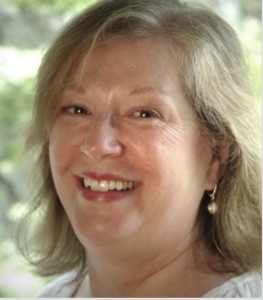 Relevant History welcomes back Ana Brazil, a longtime student of history and a voracious reader of mystery. Her historical mystery novel and short stories feature brash American heroines, the more bodacious the better. Ana’s debut novel, Fanny Newcomb and the Irish Channel Ripper, won the 2018 IBPA GOLD Medal for Historical Fiction. Her current work-in-progress features a vaudevillian-chanteuse-who-knows-too-much set in 1919 San Francisco. Ana is an active member of Sisters in Crime and the Historical Novel Society, and a founding member of the Paper Lantern Writers Collective of historical fiction writers. To learn more about Ana and her fiction, visit her web site, and follow her on Facebook, Twitter, Instagram, Pinterest, and Goodreads.
Relevant History welcomes back Ana Brazil, a longtime student of history and a voracious reader of mystery. Her historical mystery novel and short stories feature brash American heroines, the more bodacious the better. Ana’s debut novel, Fanny Newcomb and the Irish Channel Ripper, won the 2018 IBPA GOLD Medal for Historical Fiction. Her current work-in-progress features a vaudevillian-chanteuse-who-knows-too-much set in 1919 San Francisco. Ana is an active member of Sisters in Crime and the Historical Novel Society, and a founding member of the Paper Lantern Writers Collective of historical fiction writers. To learn more about Ana and her fiction, visit her web site, and follow her on Facebook, Twitter, Instagram, Pinterest, and Goodreads.
*****
In an earlier Relevant History post, I shared my long-standing love of Sanborn Fire Insurance maps, which I used extensively in my research of Gilded Age New Orleans. Today I’m sharing my fascination with Turn-of-the-Century-and-slightly-beyond postcards. Or as I call them, “the best hold-it-in-your-hand-history ever.”
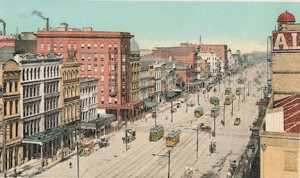
Many, many historians have detailed the history of postcards much better than I could ever hope to, but I will share these two first facts: the first known postcard was sent through London in 1840 and the first known American postcard was sent in December 1848.
From those 19th-century dates, postcards made a slow but steady ascent into the lives of mail-sending people across the globe. Postcards reached their Golden Age during the years 1907-1913-ish when postcards were produced, sold, sent, and collected at an astounding rate.
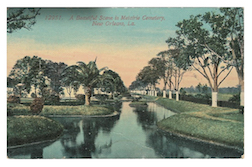 Fortunately for all, the Golden Age of postcards intersected with the turn-of-the-century City Beautiful movement (a concerted effort to enhance the appearance of American towns and cities) and with the advent of automobile-inspired tourism. As a result, postcards of the Golden Age showed off the best and brightest of a city’s civic buildings, parks, churches, residences, and commercial areas. And don’t forget the cemeteries! I’ve collected countless postcards of New Orleans’ lushly landscaped Metairie and St. Louis cemeteries.
Fortunately for all, the Golden Age of postcards intersected with the turn-of-the-century City Beautiful movement (a concerted effort to enhance the appearance of American towns and cities) and with the advent of automobile-inspired tourism. As a result, postcards of the Golden Age showed off the best and brightest of a city’s civic buildings, parks, churches, residences, and commercial areas. And don’t forget the cemeteries! I’ve collected countless postcards of New Orleans’ lushly landscaped Metairie and St. Louis cemeteries.
A primary source you can afford to collect
Vintage postcards are absolutely one of the easiest primary sources to collect. They’re small, they’re flat, and they usually cost less than $5.00 apiece to purchase.
I purchased my first New Orleans postcards in Magazine Street and French Quarter antique shops. I quickly graduated to searching out postcards at flea markets, swap meets, and garage sales in the south. When EBay came along, my New Orleans postcard collection seemed to explode with inspiring images.
The variety of images types is vast:
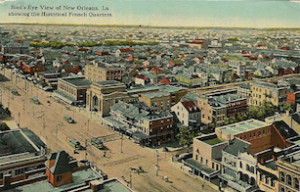 Bird’s eye postcards—just like the bird’s eye maps that inspired them—provide an overview of all or parts of the city.
Bird’s eye postcards—just like the bird’s eye maps that inspired them—provide an overview of all or parts of the city.
.
.
.
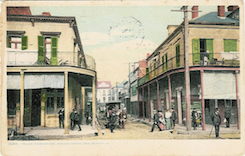 Streetscapes give you an idea of a manageable landscape, including these Italian Headquarters.
Streetscapes give you an idea of a manageable landscape, including these Italian Headquarters.
.
.
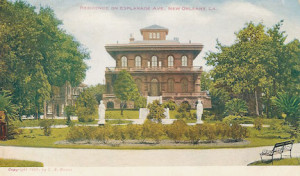 Blocks & Buildings. New Orleans has always been renowned for glorious residences (like this one on Esplanade Avenue), many of which were built on entire city blocks.
Blocks & Buildings. New Orleans has always been renowned for glorious residences (like this one on Esplanade Avenue), many of which were built on entire city blocks.
.
.
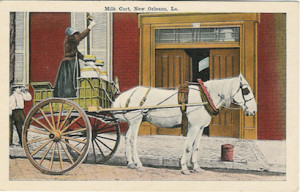 People, Places, & Things—I’ve always wanted to put this milk seller (and the carefree boy in the boater leaning against an electrical pole) into one of my stories, but just haven’t found the right place for either of them yet.
People, Places, & Things—I’ve always wanted to put this milk seller (and the carefree boy in the boater leaning against an electrical pole) into one of my stories, but just haven’t found the right place for either of them yet.
.
How to use your postcards creatively
I’ve studied each of my postcards, often with a jeweler’s loupe, for clues about life in New Orleans. The details abound—the blue and white striped awnings in the French Quarter, the statues on the lawn, the canals and palm tress in the cemetery, the six lanes of traffic on Canal Street—and go into my scenes, chapters, and stories about New Orleans.
And I always read the Message and Address on the postcard back in hopes of coming across something useable. Should I change a character’s name to “Mrs. Lottie Ulrich?” How about “Mrs. Edgar R. Patterson?” Or should I address each married woman character as “Mrs.” more often?
And what writer isn’t intrigued by these postcard messages?
After a haircut-shave, shampoo and massage I looked so young I immediately started for Chicago. I did enjoy your visit so and can’t thank you enough.
I’m here [in New Orleans] and feeling fine as silk.
Another week and I’ll be eating real grub.
The voices of the past make the entire city feel alive to me. And hopefully that translates in my writing.
I enjoy my New Orleans postcard images so much that I’ve integrated them into blog posts and my website. I’ve also used them as swag (I give away reproduced postcards instead of bookmarks) and as book club show-and-tell.
For anyone interested in Turn-of-the-Century urban American, I cannot recommend postcards of the era enough!
I hope you have the opportunity to wander through a box of old postcards someday soon. Just find one postcard that delights you, hold-it-in-your-hand, and let the images and words of the past perform their magic.
*****
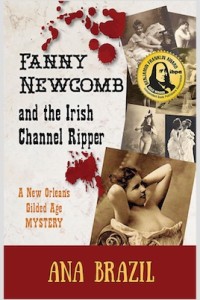 A big thanks to Ana Brazil! She’ll give away a packet of four reproduction postcards and one original postcard of Italian Headquarters, plus a paperback copy of Fanny Newcomb and the Irish Channel Ripper, to someone who contributes a comment on my blog this week (available Tuesday 4 February). I’ll choose the winner from among those who comment by Friday at 6 p.m. ET. Delivery is available in the US only.
A big thanks to Ana Brazil! She’ll give away a packet of four reproduction postcards and one original postcard of Italian Headquarters, plus a paperback copy of Fanny Newcomb and the Irish Channel Ripper, to someone who contributes a comment on my blog this week (available Tuesday 4 February). I’ll choose the winner from among those who comment by Friday at 6 p.m. ET. Delivery is available in the US only.
**********
Did you like what you read? Learn about downloads, discounts, and special offers from Relevant History authors and Suzanne Adair. Join Suzanne Adair’s Patreon, and subscribe to her free newsletter.

I love history. My particular interest is the 19th Century – a century of revolutions and revolutionary change. I am enthralled with New Orleans and their French connection. In fact, I am looking for more information about New Orleanians (is that a proper connotation?) exodus back to Paris after the Civil War. I also love all things Irish (Scots/Irish Ancestry here) and diabolical murder mysteries! Seems we have much in common ladies…
hmmmm…I’ve never thought about a post-Civil War New Orleanian (yep, that’s it) exodus to Paris. I’ve always been too interested in all of the new Irish and Italian immigrants moving into New Orleans!
Glad you love New Orleans; it’s such a fascinating city, then & now!
Old postcards are fascinating! I have several that my grandmother made, as part of her photography business, of Inverness, California in the early 1900s. A fun way to look at history!
thanks, Linda! I’ve almost never met a vintage postcard that I didn’t like!
I love this!
Thanks, Sarah. I really enjoyed sharing my postcards in this post.
Love the breakdown of the different types of postcards. I’m headed over to eBay right now to shop for some!
Yep, Ebay is great & a lot of vendors will offer you deals on shipping multiple postcards. Be sure to ask about that.
What a great way to get insights into every day life.
Thanks, Charity!
Ana! What a great post! I love vintage postcards also. I’ve collected them for over 30 years. Actually longer – the first ones I got were from one of the elderly ladies I grew up next door to. When she passed, I got a collection of her old postcards and photographs. I’ve been hooked ever since.
I never thought of using them for swag at book signings etc. What a terrific idea! I’m going to PM you.
Thanks for a fun read!
I love finding collections of cards, because they show a special relationship between the sender and receiver. Sometimes they’re almost like love letters
Interesting post, as always. I had enjoyed your post on fire maps.
It is unnerving to realize that post cards scribbled in my youth are approaching antique status. Amongst “real” antique post cards, my favorites are small town views.
Thanks, Liz!
Thank you for sharing this unusual way of researching history. I love rummaging through antique and thrift stores. I’ll look for postcards now. Lynn
Thanks, Lynn. Good luck hunting!
A very interesting, and personal, way of researching your novel. I’d be interested in seeing a larger image of the first one you show at the end of the article. It appears to be an aerial shot of Basin and Rampart Streets at Canal Street. I’d love to know when it was printed, too.
Hi Kerry.
You’re right, that postcard shows Basin & Rampart at Canal Street. The image was definitely printed after 1908, because that’s the date that the Southern Railroad Depot (the large monumental building with a rounded arch entrance on Canal and Basin Streets) was completed.
I have two copies of this postcard, one with a white border, one without. Neither one of the copies has a true date on the back.
I enlarged the postcard image and added to my blog @ https://anabrazil.com/its-giveaway-time-for-48-hours-or-so/.
If you want to see it really blown up, let me know and I’ll see what I can do.
It’s so fun to share these images with other people who enjoy New Orleans!
Thanks, Lynn. Good luck hunting!
My grandfather had some Pen Pals who didn’t share letters, but they sent post cards. This was from around 1910-1917. I have a good-sized stack of them, and like you, they fascinate me. Some were quite surprising. I loved your post! By the way, I’ve already read the book you’re giving away and truly enjoyed it.
Marja, your comment reminds me that…for many people who don’t enjoy writing letters (of any length!), sending a postcard was an easy way to keep in touch with friends and family without having to say lots.
Thanks for letting me know that you enjoyed FANNY NEWCOMB & THE IRISH CHANNEL RIPPER!
I love old postcards. When I was writing my book about a young man in World War I doing relief work, I found a postcard of the ship he was on when he went to France (not from him though). I kept that and a few postcards of bombed out French towns on my bulletin board for inspiration.
Old postcards *are* inspiring, even when they’re emotionally devastating–like your postcards of bombed out French towns.
I’d love to know more about your book…I’ve got plans for an “American in France during WWI” story too.
What a fine post on postcards! Thank you, Ana. The enthusiasm you have for collecting them and sharing your knowledge of the different types of certainly came through to me. Your post here reminded me of my recent quick trip to an antique store searching for book boxes, which are few and far between, and in my search I discovered a plethora of vintage postcards! Because I have a few friends who also collect them, I decided to take a closer look. After reading this, though, I will have to go back to that antique shop and spend more time with that album-full of postcards.
Thanks, Alice! The nice thing about postcards is that you can zip through them quickly to find the images that resonate with you. And don’t forget, the messages–and even addresses and stamps–on the backs are sometimes just as fascinating.